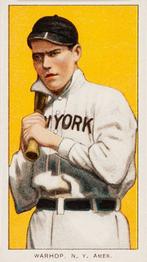May 12, 1915: Yankees’ Jack Warhop beats Cleveland despite triple play
 On May 6, 1915, New York Yankees pitcher Jack Warhop threw a pitch that gave him an unwanted place in baseball history. In the third inning of a game against the Boston Red Sox, Warhop surrendered a home run to rookie pitcher Babe Ruth. It was the first of Ruth’s 714 career round-trippers, a big-league record from Ruth’s retirement in 1935 until Henry Aaron broke it in 1974. It was also the second of seven homers Warhop surrendered in 1915, which were enough to tie him for the AL lead in that undesirable category.1
On May 6, 1915, New York Yankees pitcher Jack Warhop threw a pitch that gave him an unwanted place in baseball history. In the third inning of a game against the Boston Red Sox, Warhop surrendered a home run to rookie pitcher Babe Ruth. It was the first of Ruth’s 714 career round-trippers, a big-league record from Ruth’s retirement in 1935 until Henry Aaron broke it in 1974. It was also the second of seven homers Warhop surrendered in 1915, which were enough to tie him for the AL lead in that undesirable category.1
Warhop came out on the short end of another notable feat in his next start, on May 12 against the Cleveland Indians. Cleveland first baseman Roy Wood and shortstop Ray Chapman teamed up on an eighth-inning triple play, the second triple play in the majors that season and the first in the AL.2 To add insult to injury, Warhop was one of the two Yankee runners caught off base on the play.
Unlike the May 6 game, in which he took a no-decision, Warhop came out a winner against the Indians. The righty pitched a complete-game six-hitter – and all of his pitches stayed in the yard – as the Yankees triumphed, 4-2.
The Yankees and the Cleveland Naps had held down the bottom end of the AL in 1914.3 The Cleveland team rolled out a new nickname in January 1915, selecting “Indians” to replace “Naps” after star player and former manager Nap Lajoie was sold to the Philadelphia Athletics.4 Manager Joe Birmingham’s newly renamed squad held fifth place with an 11-12 record going into the May 12 game, 6 games behind first-place Detroit. That record included a 3-1 defeat of the Yankees on May 11 in the first of a four-game series.
The Indians’ biggest offensive weapon as of May 12 was Shoeless Joe Jackson, whose .353 batting average ranked third in the league among qualifying hitters and who also placed near the top in home runs, doubles, and slugging average. (Jackson was traded in late August to the Chicago White Sox, where he attained infamy as a participant in the 1919 “Black Sox” scandal.)
Bill Donovan’s Yankees entered in second place, 3½ games behind Detroit, with a 12-8 record. Perhaps the New Yorkers’ leading offensive threat was Fritz Maisel, whose 13 stolen bases led the league and whose 19 runs scored also ranked among the leaders. On the other end of the scale, Warhop’s 4.88 ERA after three starts placed him fourth worst in the league among qualifying pitchers.5
Opposing Warhop for the Indians was righty Roy Walker, making his first start of 1915 – and his first in the major leagues – after four relief appearances. He entered with no wins or losses and a 5.06 ERA. The tempestuous Walker had pitched a single game in relief for Cleveland in 1912, then returned to the minor leagues for two seasons. He’d also spent three months in a workhouse after the 1912 season, his sentence for a conviction related to a fight and stabbing in Nashville, Tennessee.6
After an uneventful first inning, the Yankees moved a runner to third base in the second inning, as Doc Cook walked and advanced on two groundouts. A third groundout, by Les Nunamaker, ended the scoring threat.
The Indians had more success in the bottom half. Jack Graney doubled to right field with one out. The next hitter, Wood, had appeared in 12 games, all but one as a pinch-hitter or defensive substitute; he was hitless in 12 at-bats. He snapped his streak with a single to left field, scoring Graney for a 1-0 Cleveland lead. Wood was then thrown out trying to steal second, and Bill Wambsganss’s lineout to left field ended the inning. (Wambsganss was playing third base on this day. In October 1920 he achieved lasting renown as a second baseman, pulling off the first unassisted triple play in World Series history.)
A similar pattern played out in the fourth inning, as an unsuccessful New York threat was followed by a Cleveland run. In the top half, Cook reached first on a force play and Roy Hartzell walked with two outs. Luke Boone’s foul fly to right, caught in “sensational” fashion by Jackson, ended the inning.7 In the Indians’ half, Terry Turner led off with a double to right field. Chapman bunted him to third. Turner appeared to be out at home on Jackson’s grounder to third, as Maisel fielded the ball one-handed and made a strong throw. But Nunamaker dropped the throw in a collision with Turner, who scored for a 2-0 lead.8
The Yankees continued their flirtation with scoring in the fifth. Nunamaker and Warhop began the inning with singles; when the Indians threw to third in an unsuccessful attempt to retire Nunamaker, Warhop took second. Nunamaker tried to score on Maisel’s grounder to third but was thrown out at home. Former Nap Roger Peckinpaugh’s grounder to Chapman forced Maisel at second, and Hugh High’s grounder to Turner at second led to another, inning-ending force at the keystone sack.
The score remained 2-0 until the top of the seventh. Nunamaker, who’d entered the game hitting .189, collected a leadoff single for his second hit. One out later, Maisel grounded to Wood, who threw wildly to Walker covering first.9 Nunamaker took third base on the error and Maisel moved to second. Peckinpaugh, who had briefly managed the Yankees in 1914 and later managed the Indians for parts of seven seasons,10 tripled into the left-field corner11 and scored on a wild pitch by Walker. High walked, took second on a groundout, and scored on Cook’s single to right field for a 4-2 Yankees lead.
The 2,500 fans on hand at League Park12 could be excused for thinking that the Yankees were about to pile on again in the eighth inning. Nunamaker singled again to lead off. Warhop grounded to the mound, but Walker threw too late to Chapman at second, and both runners were safe with Maisel coming to the plate.
Maisel lined a shot to first base, where Wood caught it on the fly and stepped on first to retire Warhop. His quick throw to Chapman at second retired Nunamaker to squelch the Yankee rally. The New York Sun emphasized that neither runner had strayed far from the bag: “The threefold killing was not due to faulty base running by the victims, but to speedy execution on the part of the makers of this baseball rarity.”13
Entering the bottom of the ninth, Warhop had allowed the Indians just four hits, none since the fourth inning. Turner grounded out to begin the inning, but Chapman and Jackson hit back-to-back singles to put the tying runs on base. Graney’s grounder to first moved the runners ahead 90 feet, setting up a climactic faceoff between Warhop and Wood. The first baseman, involved in so many of the game’s key events, hit a foul fly to left that Hartzell reeled in for the last out. The game took 1 hour and 50 minutes to complete.
The Cleveland Plain Dealer reported that Walker had “pitched a star game,” but chided him for walking seven batters. Walker compiled a 17-27 record in a six-season big-league career that ended with the 1922 St. Louis Cardinals.
As for Warhop, the Plain Dealer reported that the Yankees hurler “never showed better form against a Cleveland club than he did yesterday, having perfect control of his underhand delivery.”14
Warhop won six more games in 1915 to close with a 7-9 record. He faced the Indians in his final game on August 12, giving up seven hits and five runs – four earned – in 3 2/3 innings. Two days later, the Yankees released him to Richmond of the International League; Warhop refused to report, retiring instead.15 He subsequently returned to the minors, pitching there until 1928, but never reached the majors again.
The Yankees ended the season in fifth place with a 69-83 record and two ties, 32½ games behind first-place Boston. The Indians finished seventh at 57-95 with two ties, 44 1/2 games back. The Cleveland team’s poor play cost manager Birmingham his job eight days after the loss to Warhop and the Yankees.16
Acknowledgments and author’s note
This story was fact-checked by Gary Belleville and copy-edited by Len Levin. It is part of a project by the author to write stories on all eight American, National, and Federal League games played on May 12, 1915.
The author thanks SABR member Vince Guerrieri for research assistance.
Photo credit: Jack Warhop, Trading Card Database.
Sources
In addition to the sources cited in the Notes, the author used the Baseball-Reference.com and Retrosheet.org websites for general player, team, and season data and the box scores for this game.
https://www.baseball-reference.com/boxes/CLE/CLE191505120.shtml
https://www.retrosheet.org/boxesetc/1915/B05120CLE1915.htm
Notes
1 Warhop’s Yankee teammate Ray Fisher also gave up seven homers in 1914. Warhop had also led the AL in homers surrendered in 1914, with eight.
2 SABR Triple Play Database, accessed February 2025, https://sabr.org/tripleplays. The 1915 season’s first triple play was pulled off on May 6 by four players on the Federal League’s St. Louis Terriers.
3 The Yankees’ 70-84 record, with three ties, tied them with the Chicago White Sox for sixth place. The Naps finished last at 51-102 with four ties.
4 Marc Bona, “100 Years Ago, Naps Became Cleveland Indians,” Cleveland.com, January 16, 2015, https://www.cleveland.com/tribe/2015/01/100_years_ago_naps_became_clev.html. For a deep dive into the name change and related myths, see Joe Posnanski, “The Cleveland Indians, Louis Sockalexis, and the Name,” HardballTalk.com, March 18, 2014, https://www.nbcsports.com/mlb/news/the-cleveland-indians-louis-sockalexis-and-the-name. The franchise changed its name once again to the Guardians for the 2022 season.
5 Warhop ranked behind Boston’s Ray Collins (5.85 ERA), Philadelphia’s Rube Bressler (5.08), and Cleveland’s Fritz Coumbe (5.00).
6 It could have been worse: Walker’s sentence was originally 10 years in prison, but it was reduced on appeal. Chris Rainey, “Roy Walker,” SABR Biography Project, accessed February 2024. https://sabr.org/bioproj/person/roy-walker/.
7 “Lucky Seventh Brings Victory to the Yankees,” New York Tribune, May 13, 1915: 14.
8 “Lucky Seventh Brings Victory to the Yankees”; “Castoff Smites Three Base Blow to Lead Indians,” New York Sun, May 13, 1915: 10.
9 Henry P. Edwards, “Peckinpaugh Leads Attack Which Beats Indians,” Cleveland Plain Dealer, May 13, 1915: 13.
10 Peckinpaugh went 10-10 as Yankees manager in September 1914. He managed Cleveland from the start of the 1928 season through June 1933, and then again for the entire 1941 season.
11 Edwards, “Peckinpaugh Leads Attack Which Beats Indians.”
12 Retrosheet and Baseball-Reference listed the attendance as 2,230 in February 2024. New York and Cleveland newspaper accounts gave an attendance of 2,500.
13 “Castoff Smites Three Base Blow to Lead Indians.”
14 Edwards, “Peckinpaugh Leads Attack Which Beats Indians.”
15 “Three Yanks Go to Richmond,” Buffalo News, August 14, 1915: 3; International News Service, “Jack Warhop Released,” Buffalo Enquirer, August 18, 1915: 6.
16 Louis A. Dougher, “Birmingham Is Let Out from Managership of Cleveland,” Washington Times, May 12, 1915: 16. Lee Fohl replaced Birmingham for the remainder of the season, staying until July 1919.
Additional Stats
New York Yankees 4
Cleveland Indians 2
League Park
Cleveland, OH
Box Score + PBP:
Corrections? Additions?
If you can help us improve this game story, contact us.

